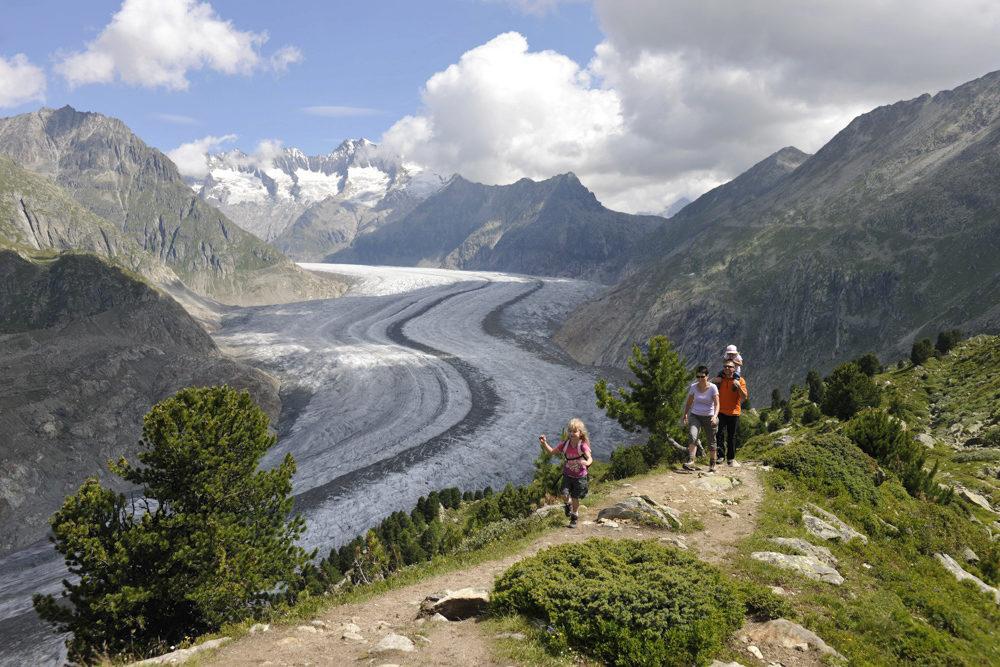The Great Aletsch Glacier
The Great Aletsch Glacier
is a vision of primaeval beauty. High up on the Moosfluh, Bettmerhorn and Eggishorn viewpoints is the best place to admire the scale and unique magic of the Great Aletsch Glacier.

This huge river of ice that stretches over 23 km from its formation in the Jungfrau region (at 4000 m) down to the Massa Gorge, around 2500 m below, fascinates and inspires every visitor.
Tip:
A great way to experience the immense sea of ice is on a guided glacier walk.Detailed information about the glacier and the most liberating nature experience of the Alps can also be found at Glacierworld Bettmerhorn multimedia exhibition and at the Pro Natura Center Aletsch.

How glaciers shape the landscape
The Great Aletsch Glacier has shaped the landscape of the Aletsch Arena over thousands of years. During the last ice age (around 18,000 years ago), ice still covered the mountain ridges between the Bettmerhorn and the Riederhorn; only the peaks rose above the ice. How do we know?
The landscape tells us: the area that was then covered by ice is smooth and rounded, but the shapes of the Bettmerhorn and Eggishorn are sharp and jagged.
We can also trace how the Great Aletsch Glacier has grown and receded in the landscape of the Aletsch Forest. Around 11,000 years ago, the terminus of the glacier was in the Rhône Valley and the glacier's edge reached almost as far as Riederfurka.
The immense lateral moraine that was formed in the process is clearly visible from the moraine trail. The maximum extension of the Great Aletsch Glacier to date was around 1860.
At that time, it was around 3 km longer than it is today and the edge of the glacier was a good 200 m higher, near the Aletsch Forest. This area still stands out against the surrounding countryside as a light strip of land with fairly young vegetation.


Did you know:
When two glaciers merge, the lateral moraines join and form a medial moraine. As three large firn fields meet at Concordia, the Great Aletsch Glacier has in fact two medial moraines. These appear as dark lines running along the length of the glacier. Looking in the direction of flow, the glacier's right-hand medial moraine is the Kranzberg medial moraine and the left-hand medial moraine is the Trugberg medial moraine.
The effects of climate change
Global warming is also affecting the Aletsch Arena's "ice sea" to a concerning extent. Measurements by the Pro Natura Center Aletsch show that the Great Aletsch
Glacier is experiencing dramatic ablation, shrinking by up to 50 metres in length each year and retreating significantly at the edges.
The Great Aletsch Glacier: facts and figures
Length
23 km – making the Great Aletsch Glacier the longest in the Alps.
Surface area
86 km2; Concordia – where the Grosser Aletschfirn, Jungfraufirn, Ewigschneefeldfirn and Grüneggfirn firn fields merge – is large enough to hold a town such as Chur, Bellinzona or Frauenfeld.
Weight
11 billion tonnes, or the weight of 72.5 million jumbo jets.
Maximum ice thickness
More than 900 m at Concordia.
Velocity
The ice formed in the catchment area of the glacier moves downhill like a viscous mass, providing a constant supply of ice to the snout. The distance covered by the ice over time in the process is the glacier's velocity. The velocity of the Great Aletsch Glacier is 200 m per year at Concordia, and 80 – 90 m per year at the level of the Aletsch Forest.
A huge store of water
If this mass of ice were melted, it could supply every single person on the Earth with a litre of water every day for 4.5 years.
Further reading:
Aletsch – eine Landschaft erzählt. Laudo Albrecht. Fourth volume in the series "Die Reichtümer der Natur im Wallis". Rotten Verlag AG Visp, 1997.
